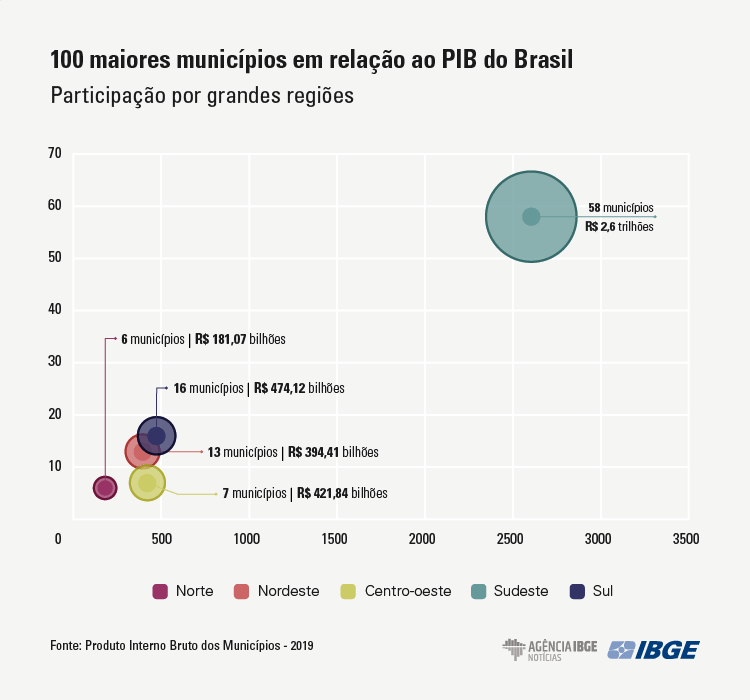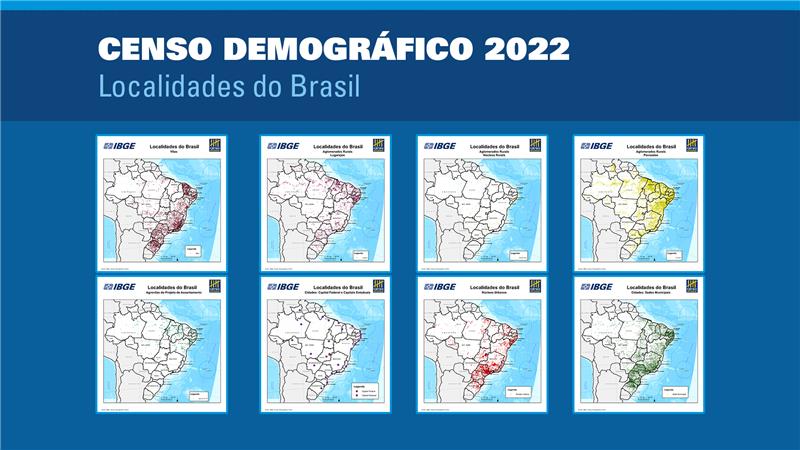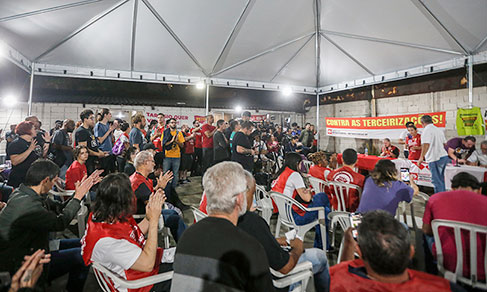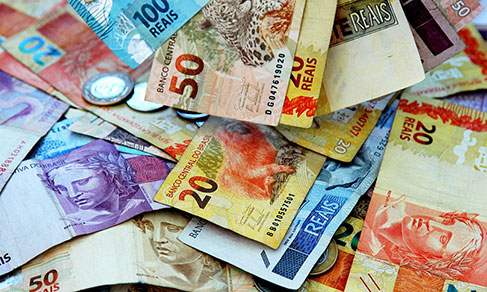GDP of Municipalities
São Paulo accounted for 10.3% of Brazilian GDP in 2019
December 17, 2021 10h00 AM | Last Updated: December 24, 2021 11h21 AM
Highlights
- In 2019, São Paulo(SP) concentrated 10.3% of the Brazilian Gross Domestic Product (GDP).
- Besides São Paulo, Maricá and Saquarema, in Rio de Janeiro, Parauapebas, in Pará, Brasília, in the Federal District, and São José dos Pinhais, in Paraná, were the municipalities that mostly gained share over 2018.
- Although it gained share against the previous year, São Paulo lost 2.3 percentage points (p.p.) in the comparison with the beginning of the time series, in 2002.
- Rio de Janeiro was the second municipality that mostly lost share in the GDP in 17 years (-1.5 p.p.).
- Eight municipalities accounted for nearly 25% of the GDP in 2019: São Paulo (SP), with 10.3%; Rio de Janeiro (RJ), with 4.8%; Brasília (DF), with 3.7%; Belo Horizonte (MG), with 1.3%; Curitiba (PR), with 1.3%; and, with 1.1% each, Manaus (AM), Porto Alegre (RS) and Osasco (SP).
- Of the 25 biggest municipalities in relation to the Brazilian GDP, 11 are capitals.

The city of São Paulo was responsible for 10.3% of the Brazilian Gross Domestic Product (GDP) in 2019, adding up to R$763.8 billion. That municipality was one of those that mostly gained share in the sum of all final goods and services produced in Brazil compared with the previous year. The others were Maricá and Saquarema, in Rio de Janeiro, Parauapebas, in Pará, Brasília, in the Federal District, and São José dos Pinhais, in Paraná, with an increase of 0.1 percentage points each. The data are from the GDP of Municipalities, released today (17) by the IBGE.
Although São Paulo increased its share by 0.1 p.p. compared with the previous year, it was the municipality that mostly dropped in the comparison with the beginning of the time series of the survey, in 2002. The loss of 2.3 p.p. in the period is explained by the relative decrease in financial activities, insurance and related services.
For Luiz Antonio de Sá, an IBGE analyst of National Accounts, the retreat in the share of São Paulo represents a trend of reduction in the concentration of the GDP in few Brazilian cities. “In spite of municipalities with a high share in the GDP, like São Paulo and Rio de Janeiro, the concentration tends to decrease since the beginning of the time series. In this period, other municipalities ranked in higher positions in value of GDP, as they stood out in some economic activities, especially those related to industries. Some states advanced in power generation, others in agriculture. Therefore, important activities for the economy impacted the gain of share of other municipalities. And, in the face of that advance, the share of São Paulo reduces,” states him.
Following São Paulo, Rio de Janeiro is the municipality that mostly lost share in the GDP in 17 years (-1.5 p.p.). This drop was caused by the decrease in the weight of Rio de Janeiro in the Brazilian industry. “In Rio de Janeiro, the activity of petroleum extraction has a huge relevance. As other municipalities in Rio de Janeiro also stood out in this activity, the capital lost share in this period,” explains him.
Despite the reduction in the concentration, eight municipalities accounted for nearly 25% of the GDP in 2019. Besides São Paulo (SP), with 10.3%, and Rio de Janeiro (RJ), with 4.8%, the highest shares were Brasília (DF), with 3.7%; Belo Horizonte (MG), with 1.3%; Curitiba (PR), with 1.3% and, with 1.1% each, Manaus (AM), Porto Alegre (RS) and Osasco (SP).

The survey also points out that of the 25 biggest municipalities in relation to the Brazilian GDP, 11 are capitals. “This is a historical characteristic of Brazil, which formed long before the beginning of the time series. We can notice that the Brazilian economy is much concentrated in the capitals since 2002. The sum of the 27, also considering Brasília, represents nearly one third of the national economy. There is a deconcentration trend, though the share of the capitals is still very high,” says the analyst.
Altogether, the 25 largest municipalities accounted for 36.2% of the GDP in 2019.
Compared with 2018, Maricá, in Rio de Janeiro, was included and São Luís, capital of Maranhão, was excluded from that list. “Maricá had already been standing out in petroleum extraction and, in 2019, the output increased in the city. In the case of São Luís, the manufacturing industries retreated, especially in the segment of basic metals. The loss in the output was more decisive in the exclusion of the capital of Maranhão from the ranking of the 25 largest municipalities,” explains Sá.
When considering the 100 biggest municipalities in terms of value of GDP, the Southeast appears on the list with 58 cities, which concentrated 35.3% of the national GDP. “The predominance of Southeastern municipalities is quite evident in this division. This reality is also related to the history of Brazil. As it did not appear all of a sudden, it does not reduce all at once as well. The concentration profile is very ingrained within the distribution of the GDP. However, an advance in the deconcentration can be perceived, inasmuch as the North and Central-West are gaining share,” states him. The 100 largest municipalities added up to more than half (55.2%) of the Brazilian GDP in 2019.

Among the cities that mostly gained share since the beginning of the time series are Maricá (0.5 p.p.), in Rio de Janeiro, and Osasco (0.3 p.p.), in São Paulo. While Maricá stood out in petroleum extraction, the increase in Osasco is related to financial activities, insurance and related services.
Compared with the previous year, the biggest losses of share were registered in Rio de Janeiro (RJ), Vitória (ES), Campos dos Goytacazes (RJ) and Ouro Preto (MG).
In Rio de Janeiro, the drop was mainly associated with basic metals. In Campos dos Goytacazes, the loss was linked with petroleum extraction. Both in Vitória and Ouro Preto, the loss of share was also linked with mining and quarrying industries, especially iron ore.
Presidente Kennedy, in Espírito Santo, has the highest per capita GDP in Brazil
The ten municipalities with the highest per capita GDP added up to 1.5% of the Brazilian GDP. The highest one is Presidente Kennedy, in Espírito Santo, with R$464,883.49. It was followed by Ilhabela, in São Paulo. Those two municipalities stand out in petroleum extraction. Selvíria, in Mato Grosso do Sul, appears in the third position, due to generation of hydroelectric power.
The per capita GDP of the city-region of São Paulo, which comprises 92 neighbor municipalities with a strong interaction, corresponded to 166% of the national figure. Whenever that region is compared with either the Northeastern semi-arid or the Legal Amazon, inequality becomes more significant. In the semi-arid, the per capita GDP was 40% of the national figure, whereas that of the Legal Amazon was 66%.
Public administration prevails in nearly half of the Brazilian municipalities
In nearly half of the Brazilian municipalities (48.9%), public administration was the major economic activity in 2019. That percentage exceeded 90% in some states like Acre, Roraima, Amapá, Piauí and Paraíba, whereas that was only 9.9% in São Paulo.
Among the 241 municipalities in which the major economic activity was related with manufacturing industries, 81.7% were in the Southeast and South. Among those in which Agriculture, including support to agriculture and post-harvest, appears as the major activity, Mato Grosso recorded the highest percentage (39.7%), followed by Rio Grande do Sul (33.6%).


















